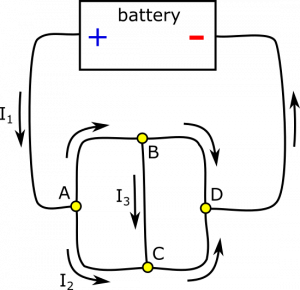This is an old revision of the document!
Example: Changing the Dimensions of a Wire
Suppose you have a simple circuit whose wire changes in thickness. The wire is 8 meters long. The first 2 meters of the wire are 3 mm thick. The next 2 meters are 1 mm thick. The last 4 meters are 3 mm thick. The wire is connected to a 12-Volt battery and current is allowed to flow. You use an ammeter and a voltmeter to find that the current through the first 2 meters of wire is I1=5 A, and the voltage across the first two meters is ΔV1=1 V. In all three segments of the wire, determine the magnitude of the electric field inside and the power transmitted.
Facts
- Segment lengths: L1=2 m, L2=2 m, and L3=4 m.
- Segment diameters: d1=3 mm, d2=1 mm, and d3=3 mm.
- Current: I1=5 A.
- Voltage: ΔV1=1 V.
Lacking
- Power and electric field in all segments
Approximations & Assumptions
- The circuit is in a steady state.
- Approximating the battery as a mechanical battery.
- The wire has a circular cross-section.
- No outside influence on the circuit.
- The wire is made of the same material throughout.
Representations
- We represent the situation with diagram below. We number the segments for simplicity of representing the quantities we are interested in.
Solution
Let's start with node A. Incoming current is I1, and outgoing current is I2. How do we decide if IA→B is incoming or outgoing? We need to bring it back to the Node Rule: Iin=Iout. Since I1=8 A and I2=3 A, we need IA→B to be outgoing to balance. To satisfy the Node Rule, we set IA→B=Iout−I2=Iin−I2=I1−I2=5 A
We do a similar analysis for node B. Incoming current is IA→B, and outgoing current is I3. Since IA→B=5 A and I3=4 A, we need IB→D to be outgoing to balance. To satisfy the Node Rule, we set IB→D=Iout−I3=Iin−I3=IA→B−I3=1 A
For node C, incoming current is I2 and I3. There is no outgoing current defined yet! IC→D must be outgoing to balance. To satisfy the Node Rule, we set IC→D=Iout=Iin=I2+I3=7 A
Lastly, we look at node D. Incoming current is IB→D and IC→D. Since there is no outgoing current defined yet, ID→battery must be outgoing to balance. To satisfy the Node Rule, we set ID→battery=Iout=Iin=IB→D+IB→D=8 A
Notice that ID→battery=I1. This will always be the case for currents going in and out of the battery (approximating a few things that are usually safe to approximate, such as a steady current). In fact, we could have treated the battery as another node in this example. Notice also that if you incorrectly reason about the direction of a current (incoming or outgoing), the calculation will give a negative number for the current. The Node Rule is self-correcting. A final diagram with directions is shown below.

